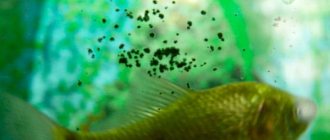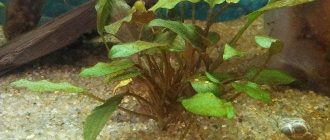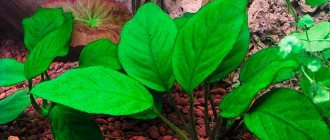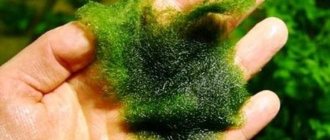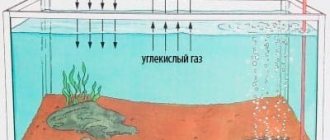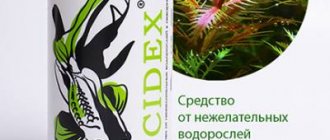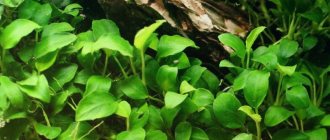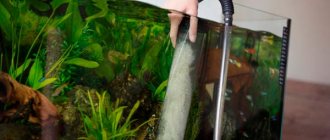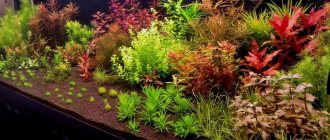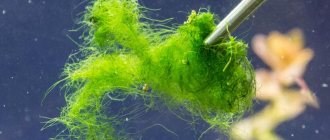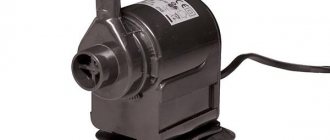Classification of fertilizers and batteries
Additives are divided into basic and complex.
In addition, the following groups are distinguished:
- starting - added after starting the aquarium;
- regular – necessary to create a minimum concentration of active ingredients;
- single-use products – eliminate starvation of plants;
- specific starting preparations - placed under the root system;
- specific liquid fertilizers - intended for containers with one type of vegetation.
Macro
Necessary macroelements include nitrogen. The substance is added regularly when carbon dioxide is supplied to the aquarium. An increase in the level of the substance is indicated by the dark green color of the leaves of the vegetation and their density.
High concentrations of nitrates lead to the proliferation of blue-green algae. In some cases, according to the designer’s idea, the aquarium should contain bright greenery. To do this, over the course of 14 days, completely replace the water 4-5 times, wash the soil and add nutrients.
Potassium and phosphorus
Potassium is added to aquariums with medium to low lighting. The optimal dosage of the component is 10-20 ppm. If necessary, the quantity is increased. With a lack of macronutrients, aquarium plants begin to turn yellow and fade.
Phosphorus keeps plants healthy and improves their growth. The best option is a low content of the element.
The volume of the incoming substance is reduced if it is part of the fish food.
Micro
Iron chelate is used to treat and prevent chlorosis in aquarium plants.
With a lack of magnesium and iron, the appearance of vegetation deteriorates and its growth deteriorates, because these microelements are involved in the synthesis of chlorophyll.
With a lack of iron, chlorosis occurs. And when the formation of chlorophyll in the leaves is disrupted, their premature yellowing occurs.
Symptoms of starvation of aquatic vegetation may vary depending on the excess or deficiency of other elements.
The damage depends on the maturity of the vegetation:
- the condition of young shoots worsens with a lack of magnesium and iron;
- old vegetation turns yellow due to a lack of zinc, boron and copper;
- when the entire plant is affected, it lacks basic nutritional components.
Microfeedings with chelated iron are used as preventative agents.
Calcium
The element improves plant growth, but its elevated levels inhibit photosynthesis. This is evidenced by the lightening of the color of the leaves and stems (in some cases to yellow or white), as well as their fragility and roughness. Calcium deficiency occurs rarely, mainly when ion exchange resins are added to the water.
More often, aquarists are faced with an excess of the element. To get rid of the problem, 3-4 young mollusks per 100 liters of water are placed in the aquarium. Ampoules are well suited for this, since their reproduction is not intensive. Large individuals are constantly in sight and can be removed if necessary.
Forms of entry
Fertilizers come in different forms.
Liquid fertilizers
To choose a fertilizer, you need to know what substance the plants lack. Micro- and macrofertilizers, as well as complex additives, are produced in liquid form. They contain one active component. Such products are common and suitable for algae, which absorb nutrients through the leaves. The main advantage is ease of use.
Solid
Solid fertilizers are well absorbed by the roots and leaves of aquarium plants.
Solid preparations are produced in the form of a nutrient substrate, granules or tablets. In most cases, tablets are placed under the roots. Such fertilizers act gradually. Their advantage is the duration of exposure.
The nutrient substrate contains useful substances that saturate the soil, which accelerates the growth of algae.
Feeding of vegetation is carried out with special clay with microelements and vitamins. Its pieces are placed under the root system or buried in the ground, having previously rolled it into balls. Clay nourishes the plants in the aquarium and absorbs all harmful compounds from the water.
Vermicompost, which is often combined with peat, water or clay, is suitable for spot fertilization. The penetration of organic substances into the substrate occurs gradually, which helps preserve the nutrient medium for a long time.
Peat saturates the soil with useful elements and regulates the acidity of the liquid. Thanks to this additive, water is softened and germs and fungi are eliminated. The additive is produced in the form of a solution, emulsion and granules. The disadvantage of the fertilizer is that the water turns yellow.
Liquid
Nowadays liquid fertilizers are in great demand.
Is it possible to use micro- and macro-fertilizers at the same time? There is an answer to this question. It is possible to create a basis for insoluble compounds if phosphate from a mixture of microelements is mixed with a mixture of macroelements. But it is important to know that you can take advantage of this opportunity if you mix liquid macro- and microelements.
Some argue that macronutrients are best absorbed by vegetation at night. But this recommendation is very questionable, since the absorption of nutrients occurs in daylight. This means that fertilizing needs to be done in the morning so that the plants receive maximum benefit.
Liquid fertilizers are used to feed free-floating plants without a root system. They get all the necessary substances through the foliage. The advantages of liquid fertilizers are that it is possible to control their quantity and mix it with water. However, you will have to fertilize regularly, as elements can be removed through the filter. Each micro- and macroelement manifests its properties in different ways.
Types of biocenoses for proper fertilization
The type of biocenosis affects the sequence of fertilizer application. There are no living creatures in Dutch phytoaquariums. Restoration of the nitrogen cycle occurs slowly due to dead plant particles. For older aquariums, root sticks and microadditives are used, while for young aquariums, only microelements are used. Dutch herbalists are difficult to care for. There are no consumers in them, and the natural biological cycle is disrupted. Because of this, the volume of Dutch containers is 300-400 liters.
Aquariums with different types of biocenosis.
Angelfish are released into large home phytoaquariums, and unpretentious fish, including rasbor and puntius, are placed in small ones. Only potassium is added to water supplemented with macroelements. Microadditives are used according to the scheme.
When the aquarium is populated with a large number of fish, feeding the plants is not necessary, and in low light it is not used at all.
In addition to population density, the ratio of animal to plant mass is taken into account. Highly lit tanks are fertilized with iron every day, but stop when a few fish are preparing to spawn.
What feeding is recommended for an aquarium?
Key recommendations include:
- Liquid fertilizers that are created at home and based on individual recipes. Best suited for medium light conditions and young plants. To achieve maximum results, you must follow the dosage.
- Liquid fertilizers for plants lacking light flux.
- Dry powder for maximally illuminated aquariums. By choosing this type of feeding, you can guarantee economical use. The main thing is to follow and follow the instructions.
The best fertilizers for aquarium plants
In order not to worsen the condition of the vegetation in the aquarium, choose feeding from trusted manufacturers. The most affordable option is products from the Zoomir company. Among other brands, aquarists highlight the following fertilizers.
Tetra
Tetra produces drugs in the form of sticks, tablets and liquids. A feature of fertilizers is the lack of effect when the specified dosage is reduced.
Fertilizers for aquarium plants.
Aquayer
Fertilizers from this manufacturer:
- “Aquayer Iron+” is a concentrated source of iron. Fertilizer helps to increase the richness of the green color of the vegetation in the aquarium and eliminate chlorosis - yellowing of leaves.
- “Aquayer Udo Ermolaeva Micro+” is suitable for all types of aquariums. The fertilizer contains many nutrients.
- Aquayer Potassium is a concentrated source of the element. It is most often lacking in containers with plants. This is evidenced by small holes on the leaves. The product must be used in the first 30 days from the moment the aquarium is launched.
- “Aquayer Udo Ermolaeva Macro+” is a complex of macroelements. The fertilizer is recommended for use with “Aquayer Udo Ermolaev Micro+”. The product is suitable for containers with a large amount of vegetation. No fertilizing is added to aquariums with additional nitrogen supply.
Eheim
Eheim ensures healthy and complete growth of plants. The line combines high-quality mineral and organic substances on a natural basis. After application, the yellow vegetation will acquire a rich green color. The dosage is indicated on the packaging.
Florastim is a fertilizer for aquarium plants in the form of tablets.
Florastim
The product is an affordable source of chelated iron with microelements in a separate package. The drug can be used alone or together with other supplements.
Some companies include chelated iron in complex fertilizers, in which the formulation may not be suitable for the selected aquarium.
Branded fertilizers
There are many types of aquarium fertilizers, differing in their composition. Unfortunately, some fertilizers are diluted flower fertilizers, which are high in nitrates and phosphates. Always check the composition of the mixture carefully. The fertilizer should not contain phosphates and nitrates (usually the composition of the mixture is indicated in the form NPK, where N, P, K is the percentage of nitrogen - nitrogen, phosphates - phosphate, potassium - potassium). Nitrates and phosphates are usually waste products of fish and additional feeding with nitrates is rarely needed. There is usually not enough potassium in water.
Make sure that the fertilizer you use contains the necessary microelements and especially iron, with a lack of which the leaves (young ones and especially those of fast-growing plants) begin to turn yellow.
Aquarium fertilizers come in two types - in the form of tablets for application to the soil (they are convenient to use when preparing the soil) and liquid fertilizers. Even if you use tablets, fertilizing with liquid fertilizers is still necessary - especially potassium, which must be present in the water because it is absorbed by the leaves, and which is usually in short supply. You can add more potassium because it does not cause algae development, like iron does, which causes filamentous algae. Unfortunately, branded fertilizers usually do not have enough potassium, and increasing the dose will only lead to the appearance of algae, so additional feeding with potassium is needed.
How to make fertilizer for aquarium plants with your own hands
You can learn how to make your own fertilizing after watching a video that describes the process.
For fertilizer you will need:
- 17.5 g boric acid;
- 1 g iron gluconate (weak chelate);
- 0.7 g zinc sulfate;
- 5.4 g manganese sulfate;
- 0.3 g copper sulfate;
- 0.2 g ammonium molybdate (per 1 l).
The components are sold in pharmacies and specialty stores. For dissolution you will need distilled water at a temperature of +30…+40°C.
Substances are added in the following sequence:
- ammonium;
- copper;
- zinc;
- manganese;
- boron;
- iron.
The resulting composition is stored in the cold. Add 0.5-1 ml to a 100 liter container.
Bookmarks 0

